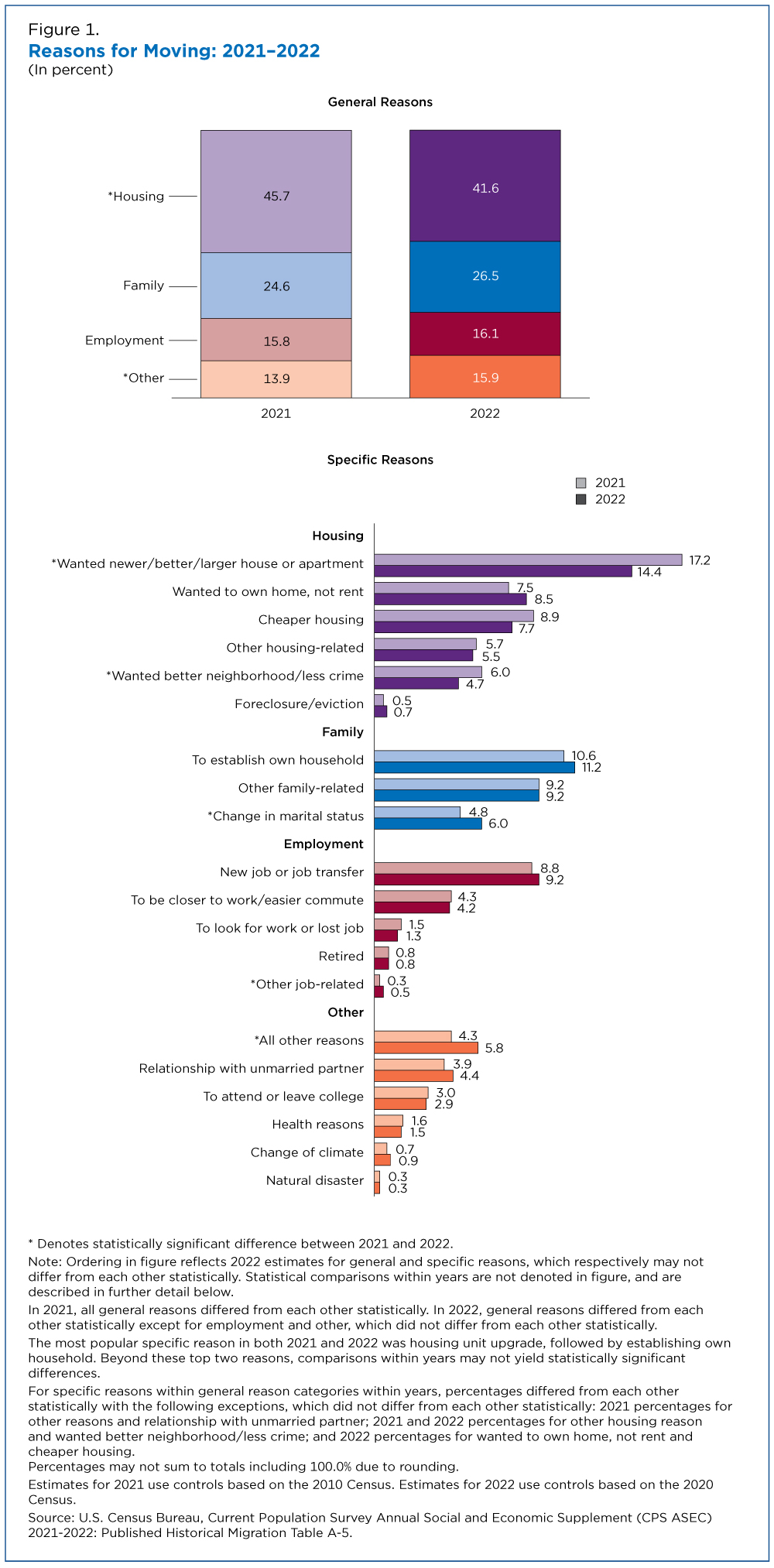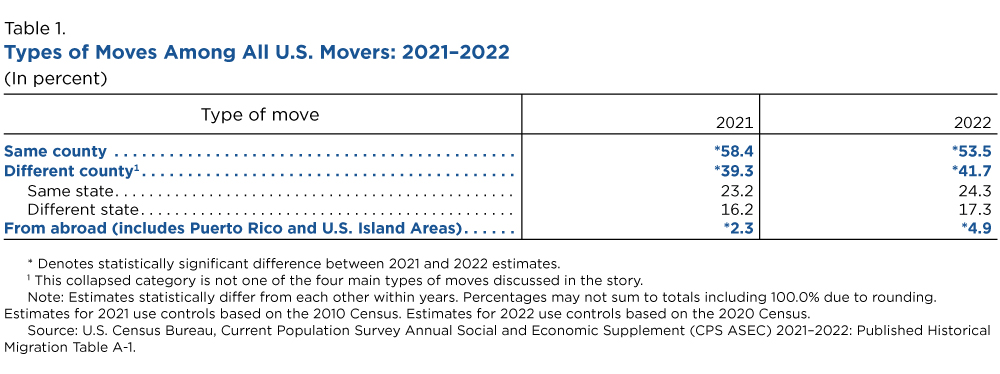Change in Marital Status Became More Common Reason for Moving from 2021 to 2022, Housing/Neighborhood Improvement Reasons Declined
A change in marital status was a more common reason for moving in 2022 than in 2021 and seeking a better housing unit or neighborhood became less common reasons, according to recently released U.S. Census Bureau data.
An increase in the share of people who moved due to a change in marital status between 2021 and 2022 may be the result of people resuming plans they had put on pause during the height of the pandemic.
The Current Population Survey Annual Social and Economic Supplement (CPS ASEC) also shows that a greater share of movers crossed county lines or moved from abroad.
The data reveal that while reasons for moving and types of moves changed, overall geographic mobility remained stable.
Reasons For Moving
The CPS ASEC asks respondents who lived in a different residence one year prior about their primary reason for moving. There are 20 specific reasons that fall into four general categories: housing-related; family-related; employment-related; and other (Figure 1).
As in several recent years, the most often-cited general category for moving in 2022 was housing-related reasons, accounting for 41.6% of movers. However, these reasons became less common between 2021 and 2022. Two specific housing-related reasons were prominent in driving this decline.
Wanting a newer, better or larger house or apartment was the most common specific reason cited for moves in 2022 and in 2021 (followed by establishing one’s own household). Despite that, the percentage of movers reporting housing unit upgrades declined.
This decline suggests reversal of a boom in housing demand that happened in 2020, early in the COVID-19 pandemic.
As people spent more time at home, home remodeling and improvement projects surged but movers also became more eager to move into nicer housing units. The share of movers seeking upgraded housing grew from 14.6% in 2020 to 17.2% in 2021. In 2022, that share dropped back to 14.4%, statistically the same as the 2020 pre-pandemic baseline.
The share of movers who reported wanting a better neighborhood or less crime experienced a similar decline following a surge early in the pandemic.
Those who sought neighborhood improvements accounted for 4.1% of movers in 2020, rose to 6.0% in 2021, only to drop to 4.7% in 2022 — still higher than in 2020.
A quarter of movers (26.5%) reported family-related reasons for their move — the second most often-cited general reason for moving in 2022 and in several recent years.
Family-related reasons include change in marital status and establishing one’s own household.
An increase in the share of people who moved due to a change in marital status between 2021 and 2022 may be the result of people resuming plans they had put on pause during the height of the pandemic. Many couples decided to postpone wedding ceremonies and large gatherings during COVID-19: an estimated 12% fewer marriages and divorces took place in 2020 than researchers expected.
The marriage drop-off is also reflected in the share of people who cited marital status as a reason for moving: 6.1% in 2020, dropping to 4.8% in 2021, and rebounding to 6.0% in 2022. The 2020 and 2022 percentages are not statistically different.
This rebound also suggests a return to pre-pandemic behaviors.
While employment-related reasons were statistically the same as other reasons in 2022 (both were least-common general reasons), this was the first time since at least 2017 that moving for employment was not cited more often.
In addition to change in marital status, the share of movers citing two other specific reasons also grew between 2021 and 2022: other job-related reason (0.3% to 0.5%), and all other reasons (4.3% to 5.8%).
Types of Moves
Where people moved also shifted between 2021 and 2022. Types of moves show where people moved from and where they went. The relative shares of the four main types of moves remained the same in 2022 as in several recent years (Table 1).
The most common type of move was within the same county, followed by moves between counties within the same state, then moves between states, and then lastly moves from abroad.
People who moved within the same county still accounted for the majority (53.5%) of movers in 2022. But their share declined by almost five percentage points since 2021. And it declined to its lowest level since 1948, when the CPS ASEC began measuring moves and showed 67.0% of movers remained within the county.
Shares of movers between different counties within the same state and between states did not change statistically from 2021 to 2022. But when combined, the share in these two categories grew from 39.3% to 41.7%. The share of movers from abroad approximately doubled, from 2.3% to 4.9% (the highest since 2018).
The high percentage moving from abroad in 2022 may have been due in part to the end of travel restrictions imposed during the pandemic.
Despite shifts in reasons for moving and types of moves, the mover rate remained at a historic low. The 2022 mover rate was 8.7%, not statistically different from the low 8.4% rate in 2021. The number of movers also remained statistically unchanged between 2021 and 2022 (about 27.1 and 28.2 million, respectively).
About the CPS ASEC Geographic Mobility Estimates
One-year CPS ASEC geographic mobility and migration estimates exclude people less than one year old. The sample includes noninstitutionalized people currently living in the United States (50 states and the District of Columbia) and living with at least one civilian adult (at least 15 years old).
Geographic mobility is measured as living in a different residence one year prior to completing the survey. Movers from Puerto Rico and the United States Island Areas are counted as movers from abroad.
COVID-19-related changes to survey operations and nonresponse may have influenced 2020, 2021, and 2022 geographic mobility estimates.
There were changes to the survey’s reason for moving categories in 2020 and 2021. Respondents moving with the householder are assigned the same reason for moving category.
The 2022 estimates in this article used 2020 Census population controls, while the 2018 to 2021 estimates used 2010 Census population controls. Estimates for 2020 and 2021 using 2020 Census population controls are included in the historical geographic mobility tables. Including the 2020 and 2021 estimates in historical mover rate comparisons did not change associated conclusions.
Technical documentation provides Information on confidentiality protection, sampling error, nonsampling error and definitions.
More CPS ASEC migration estimates are available in our historical tables, historical graphs and annual detailed tables.
Related Statistics
-
Stats for StoriesAmerican Housing Month: June 2023The 2021 American Community Survey counted 142.15M housing units, up 3.61M from 2018, and up 10.36M from 131.79M in 2010.
-
Current Population Survey (CPS)The CPS is a monthly survey sponsored by the Bureau of Labor Statistics and conducted by the U.S. Census Bureau.
Subscribe
Our email newsletter is sent out on the day we publish a story. Get an alert directly in your inbox to read, share and blog about our newest stories.
Contact our Public Information Office for media inquiries or interviews.
-
PopulationFewer People Reported Moving in Previous Year in 2021 Than in 2019April 11, 2023The share of Americans who moved in the last year declined from about 14% in 2019 to roughly 13% in 2021.
-
MigrationGoing With the Flow: State-to-State MigrationJune 08, 2023Recently released estimates show more people moved between states in 2021 than in 2019, many to and from highly populated and neighboring states.
-
PopulationThere’s No Place Like (Close to) HomeJuly 25, 2022New research shows where people move as young adults. Eight in 10 live within 100 miles of where they grew up.
-
EmploymentThe Stories Behind Census Numbers in 2025December 22, 2025A year-end review of America Counts stories on everything from families and housing to business and income.
-
Families and Living ArrangementsMore First-Time Moms Live With an Unmarried PartnerDecember 16, 2025About a quarter of all first-time mothers were cohabiting at the time of childbirth in the early 2020s. College-educated moms were more likely to be married.
-
Business and EconomyState Governments Parlay Sports Betting Into Tax WindfallDecember 10, 2025Total state-level sports betting tax revenues has increased 382% since the third quarter of 2021, when data collection began.
-
EmploymentU.S. Workforce is Aging, Especially in Some FirmsDecember 02, 2025Firms in sectors like utilities and manufacturing and states like Maine are more likely to have a high share of workers over age 55.







